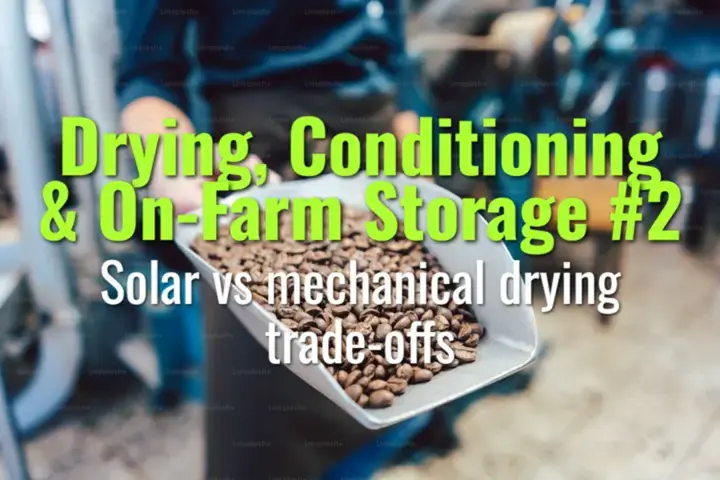Solar vs mechanical drying trade-offs
This topic explains the trade-offs between solar and mechanical drying methods for coffee, highlighting differences in cost, quality, consistency, and environmental impact.
- Coffee Basics Nerds
- 2 min read
Article 2 of 12 in Drying, Conditioning & On-Farm Storage/

Solar Drying
Method
- Coffee dried on raised beds, patios, or under solar dryers/tunnels.
- Relies on natural sunlight and airflow.
Advantages
- Low cost, sustainable, and eco-friendly.
- Preserves nuanced flavors in specialty lots.
- Flexible setups (raised beds, patios, solar tents).
Challenges
- Weather-dependent → risky in humid/rainy climates.
- Slow drying increases risk of mold/over-fermentation.
- Labor-intensive (turning, covering during rain).
Flavor Outcomes
- Often produces cleaner, more complex profiles with bright acidity.
- Slow, steady drying enhances sweetness and stability.
Mechanical Drying
Method
- Uses heated air via drum dryers, vertical dryers, or silos.
- Drying time reduced to a few days.
Advantages
- Reliable in wet/humid conditions.
- Handles large volumes quickly.
- Reduces weather-related risk.
Challenges
- High energy cost (fuel/electricity).
- Risk of overheating (>40°C) → baked or smoky flavors.
- Less nuanced cup quality compared to careful solar drying.
Flavor Outcomes
- Stable but often flatter profiles.
- Useful for bulk or commercial-grade lots.
- Specialty potential if carefully managed at low temperatures.
Hybrid Approaches
- Common strategy: Pre-dry with solar methods, finish with mechanical dryers.
- Ensures quality while reducing weather risk.
- Balances sustainability with reliability.
Trade-Off Summary
- Solar drying: Best for quality, eco-friendliness, but risky in humid climates.
- Mechanical drying: Best for reliability and volume, but higher costs and potential quality sacrifice.
Lasting Importance
The choice between solar and mechanical drying reflects climate, scale, and market goals. Specialty producers often prefer solar for quality expression, while larger estates and wet regions rely on mechanical dryers for consistency and reduced risk.
You might also like:
- Tags:
- Lasting Importance
- Cup Quality
- Flavor Outcomes
- Labor Intensive
- Raised Beds
- Low Cost
- Solar Dryers
- Bright Acidity
- Mechanical Dryers
- Risk Mold
- Commercial Grade
- Eco Friendly
- Specialty Lots
- Reduced Risk
- Slow Drying
- Humid Rainy
- Large Volumes
- Enhances Sweetness
- Increases Risk
- Rainy Climates
- Beds Patios
- Grade Lots
- Produces Cleaner
- Ensures Quality
- Smoky Flavors
- Dryers Tunnels